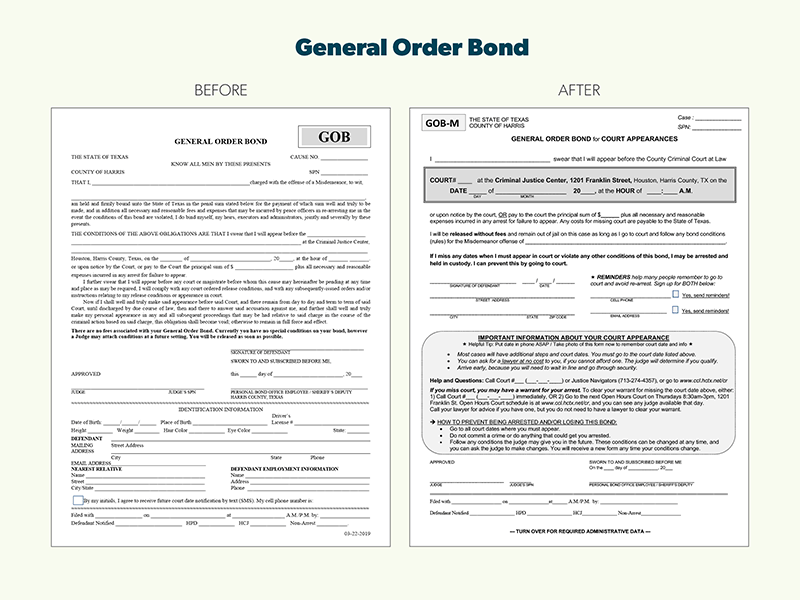Increasing Harris County Court Appearances by Adapting Tested Solutions
HIGHLIGHTS
- Harris County, Texas is now using non-monetary bonds for the majority of individuals charged with misdemeanors annually, allowing their automatic release while they await court.
- We leveraged previous work in NYC redesigning citation forms and sending timely text message reminders to increase court appearance rates in Harris County, where we designed their bond forms, notice of next court date, and court reminders by text, email or phone calls.
- These solutions can prevent thousands of new warrants from being issued each year as well as prevent people from losing their bonds and being placed in jail.
The Challenge
In Harris County, Texas, people face serious consequences for missed court dates, which can include arrest warrants, increased bail, and/or incarceration. These consequences are also costly to the legal system, given the additional time required by judges, lawyers, court staff, police, and sheriff’s offices to issue warrants, make new arrests, detain people, and hold additional court hearings.
A recent consent decree resulted in bail reform to uphold individuals’ constitutional rights and to address racial disparities in pretrial detention and post-trial outcomes. Harris County is now using non-monetary bonds for the majority of (85% of 55,000) individuals charged with misdemeanors annually, allowing their automatic release while they await court. In addition, reform efforts take critical steps to better understand the challenges around showing up to court and invest in opportunities to help people do so.
Our Approach
We worked with Harris County to help more people show up to court. Leveraging previous work showing that redesigned citations and behaviorally informed text message reminders reduce court non-appearance rates by 36%, we created:
- Text, email, and voice reminder notifications.
- Redesigned court notification forms, including four types of Bond forms, a Pretrial Supervision Requirements form, and a Notice of Next Court Date form.
We focused on making each of these forms more behaviorally informed while retaining key court information and required legislative language. We emphasized the court date as the primary piece of information by making it easy to find at the very top of the form. We also explained what someone can expect when they go to court, and what would happen if they missed their court date.
Throughout the forms, we used plain language, eliminating jargon or unfamiliar terms wherever possible. From conversations with stakeholders, we learned that people often have questions or get confused about details—for example, which courtroom to go to for their court date. In response, we included contact information, listed what to do if court dates are missed, and encouraged people to sign up for reminder messages.
Before finalizing the forms and reminders, we sought feedback from over a dozen users—both from people receiving the forms and the pretrial and sheriff’s officers filling them out. Overall, people receiving the redesigned forms reported that the new language was “very helpful” and “helps [them] feel secure.” A pretrial officer shared that it was easier to instruct people on next steps because they understood the form better. Specifically, the officer mentioned that cutting down the “legalese” made a big difference.
Testing these updates with users allowed us to revise areas where people were unclear and provided an opportunity to make improvements before the forms were implemented. For example, we enlarged the court date box on the bond forms and provided more information about the next steps under the “Do not need to appear” box on the Notice of Next Court Date form. We conducted a similar testing process with the reminder messages and found that people also preferred to receive maps, parking information, and contact information for their lawyers. Everyone said they would sign up for reminders when offered, reporting that reminders made them feel “helped,” “relaxed,” and “reassured.” One person shared, “How reassuring it is to know that there are people making sure I do what I need to do.”
Takeaway
Based on the evidence on revised forms and reminders, we expect these solutions can prevent thousands of new warrants from being issued each year, and ultimately will prevent people from losing their bonds. We hope Harris County will expand these changes to other areas beyond misdemeanors and are working to bring these changes to more jurisdictions across the United States.
Interested in learning more about this work? Reach out to us: safetyjustice@ideas42.org.












